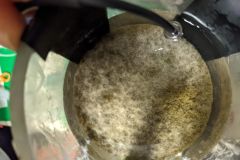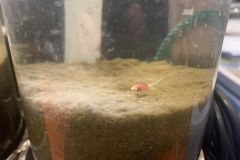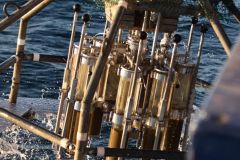
The Benguela System under climate change - Effects of Variability in physical forcing on carbon and oxygen budgets
27.01.2022 – Hydrogen sulfide – stinky, poisonous and yet at the same time an important source of energy for the giant bacteria living here.
Now we have finally arrived at the second of the four main transects in the upwelling area. This one is located at about 25°S. Contrary to our expectations, the oxygen conditions here are even lower than on the more northerly transect at 23°S. In addition to significant decreases in dissolved oxygen towards the seafloor, we also observed a significant enrichment of the water with the toxic gas hydrogen sulfide. Hydrogen sulfide is produced in the course of bacterial degradation of organic material, preferably in sediment and under oxygen-free conditions, and is released by the bacterial cells into the surrounding environment. Many of us may remember muddy sediment smelling like rotten eggs at the bottom of a lake. This odor is typical of the toxic gas hydrogen sulfide (H2S).
Another extremely interesting non-marine piece of information: hydrogen sulfide is sometimes produced in our stomachs as a result of fermentation processes and manifests itself as malodorous flatus or, among other volatile sulfur-containing compounds, as bad breath. The poisonous effect of hydrogen sulfide is based on the alteration of the oxygen binding properties of the blood pigment hemoglobin, which transports the oxygen we breathe into our cells. So far, the exact mechanism of the poisonous effect is unclear. It is assumed, however, that hydrogen sulfide reduces the binding properties of hemoglobin for oxygen and that this leads to the paralysis of intracellular respiration, i.e. the conversion of oxygen to water in our cells, which is vital for us. Death is the consequence when we inhale high concentrations of hydrogen sulfide or small amounts of it over a longer period of time.
The sediment on the so-called mud belt in the Benguela upwelling area is very rich in organic material and records correspondingly high microbial degradation rates. Here, a lot of hydrogen sulfide is formed in the sediment. However, the extent to which the formed hydrogen sulfide reaches the water column is influenced by the activity of large sulfur bacteria. These colonize the sediment surfaces along and convert the harmful gas hydrogen sulfide into other, non-toxic sulfur compounds in the course of energy production. Probably the best-known representative of these giant bacteria is the genus Beggiatoa, which can be found in many different waters: in lakes, streams or even the sea, as here in the upwelling area off Namibia. Here in the Namibian mud belt, we can find a particularly large representative of the genus Thiomargarita, the species Thiomargarita namibiensis, which was first described in 1999 by Prof. Dr. Heide Schulz-Vogt. Typical for these bacteria is the association of single cells to long filaments, similar to the well-known cyanobacteria, commonly known as blue-green algae. Filaments of Thiomargarita namibiensis can already be seen with the naked eye as small white filaments on the sediment. Seen through the stereomicroscope they look like small strings of pearls, which are either transparent or whitish. Thiomargarita species have an incredibly flexible metabolism, as well as an extraordinarily exciting and complex cell structure that is rather unusual for bacteria. Researchers even suggest that the genus Thiomargarita represents the transition between the so-called prokaryotic (e.g. bacteria, archaea, etc.) and eukaryotic (e.g. yeasts, as well as all multicellular organisms, e.g. fungi, we humans) cell structures and could revolutionize our previous understanding of prokaryotes and eukaryotes.
Representatives of the genus Thiomargarita, as well as the other giant sulfur bacteria found here, use hydrogen sulfide as an energy source, converting it into harmless sulfur compounds or even elemental sulfur. The latter is often stored intracellularly as a so-called intermediate product in the form of small sulfur spheres, thus giving the bacterial cells their typical white coloration.
Some giant sulfur bacterial species form thick white mats on the sediment surface and act as hydrogen sulfide filters at the transition between sediment and water column. How much of the toxic hydrogen sulfide now reaches the water column from the sediment via the bacterial filters depends on many different factors in addition to the activity of the cells. One of these is the oxygen itself, which is used (chemically oxidized) in the conversion of the hydrogen sulfide (chemically reduced). If oxygen is no longer available, many sulfur bacteria can also resort to other substances such as the nitrogen compounds nitrate and nitrite. However, the metabolic pathway by which nitrogen is used coupled with the conversion of hydrogen sulfide and how this affects the capacity of these bacteria to oxidize hydrogen sulfide is still poorly understood. To investigate and better understand this is part of the research of Dr. Jenny Fabian, postdoctoral researcher in the Geomicrobiology group, led by Heide Schulz-Vogt. Together, the two are investigating which different species occur here in the upwelling area and how this varies with the respective environmental conditions. Furthermore, incubations of single Thiomargarita sp. cells take place on board to investigate their cell metabolism. This includes especially the coupling of their sulfur and nitrogen metabolism.
Text: Fabian J., Braun P. (both IOW)
| Expedition: | MSM105 |
| Mission: | BUSUC 2 |
| Start: | 11.01.2022 - Walvis Bay |
| Ziel: | 23.03.2022 - Mindelo |


